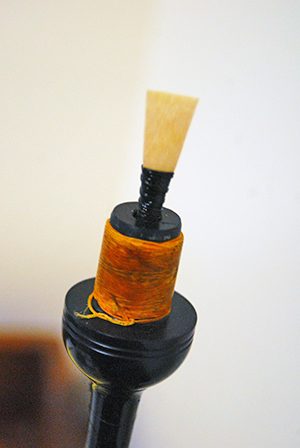Band vs Solo Chanter: What's the Difference?

If you're learning or playing the bagpipes with a band, it's common to have a pipe chanter handed to you to play when you're playing with the band, even if you already have your own.
And often, you won't get much of an explanation about why you need to play that specific one.
But usually, your bagpipes will come with a chanter provided. So what's wrong with playing one?
And if you've seen bagpipes for sale from makers, you may see that they promote them as a 'solo' or a 'band' chanter.
So why the 'band' chanter and the 'solo' chanter? Is there a difference?
The short answer is yes... and no.
Helpful, I know... but don't worry, we're about to break it down!
To start with, let's have a closer look at that mysterious chanter you were handed at band practice...
When a chanter is called a 'band' chanter, that usually means it's one that's owned by the band and is issued to players so that everyone in your pipe corps can sound as similar as possible.
Usually, your band chanter will be handed to you with a 'band reed' – again, this just means that every piper in your band has been given the same make and type of reed, so the reeds that all your bandmates are playing are as similar to each other as possible, because the closer they are to being the same, the better the whole band's chances of tuning to a similar pitch will be.
Not every piper plays their bagpipes outside of band, or has the funds to splash on their own separate set up, and for regular reeds for a second 'solo' chanter - so many pipers call their band chanter their 'regular' chanter, because it’s the one they play the most.
A solo chanter, on the other hand, simply refers to a bagpipe chanter that you play as a soloist (either as a competitor, as a performer, or just for yourself!). Many band players also have one or more solo chanters set up as an extra chanter that they switch out in alternating sessions with their band chanter.
Having a second (or third, or fourth…) chanter means you can adjust your setup and tuning to suit your own preferences – usually you don’t touch your band setup too much (i.e. you don't move the tuning tape, lift or sink the reeds, etc) so it doesn’t take too long for the pipe major to tune the band at the next rehearsal or performance.
Now, you may have seen that some makers sell a ‘regular’ or ‘band’ chanter, and then also offer a ‘solo’ version. So can a ‘band’ chanter be used for solos, or vice versa?
Yep!
The reason you'll see chanters advertised as 'solo' chanters is mostly marketing, because some makers customise certain chanters to trending solo preferences (smaller holes, different tuning, etc).
Two identical chanters could absolutely be used for either band or solo set-ups, and in fact, many soloists use their band chanters for their solo competitions.
However, there are a few drawbacks to doing this – if your solo and band competitions are held on the same day, any soloists will be harder to tune to the rest of the band because they will already have played, so will have different heat and moisture in their bag to the rest of the group.
Also, if you have a solo chanter you can do whatever you want to it! Practice balancing and tuning your own chanter is an important skill to master, and with a band chanter you won't be too popular with your pipe major if you mess around with it.
With your own solo chanter, you can experiment with different reeds too, to see how the makes and strengths affect your tone.





Responses